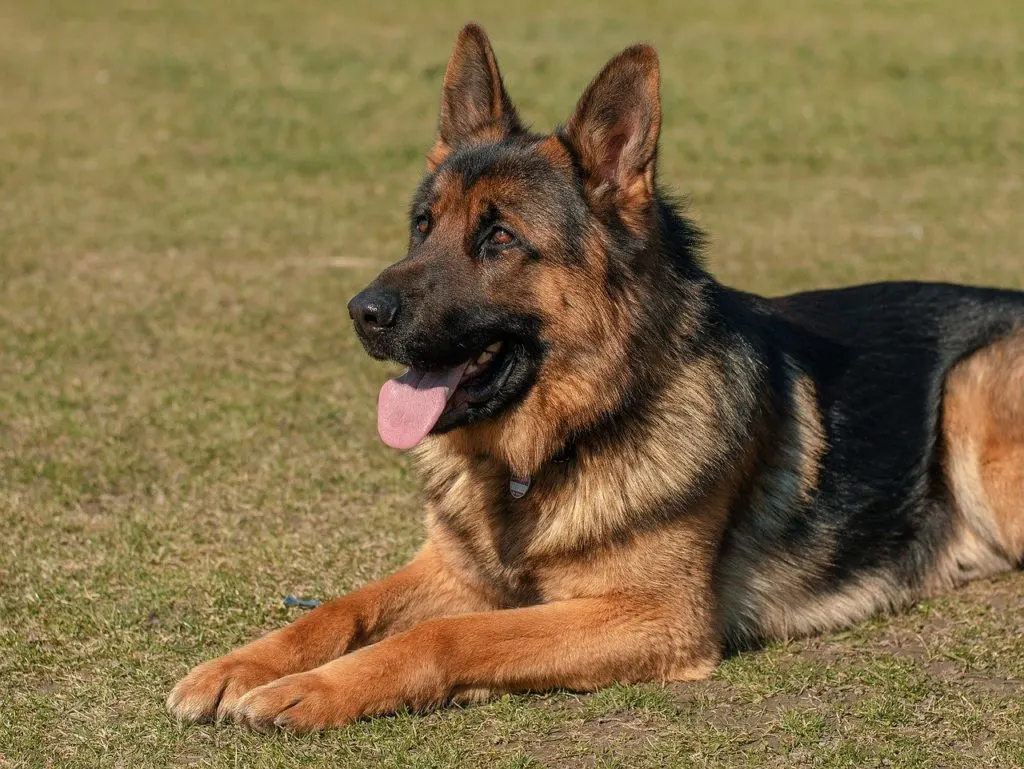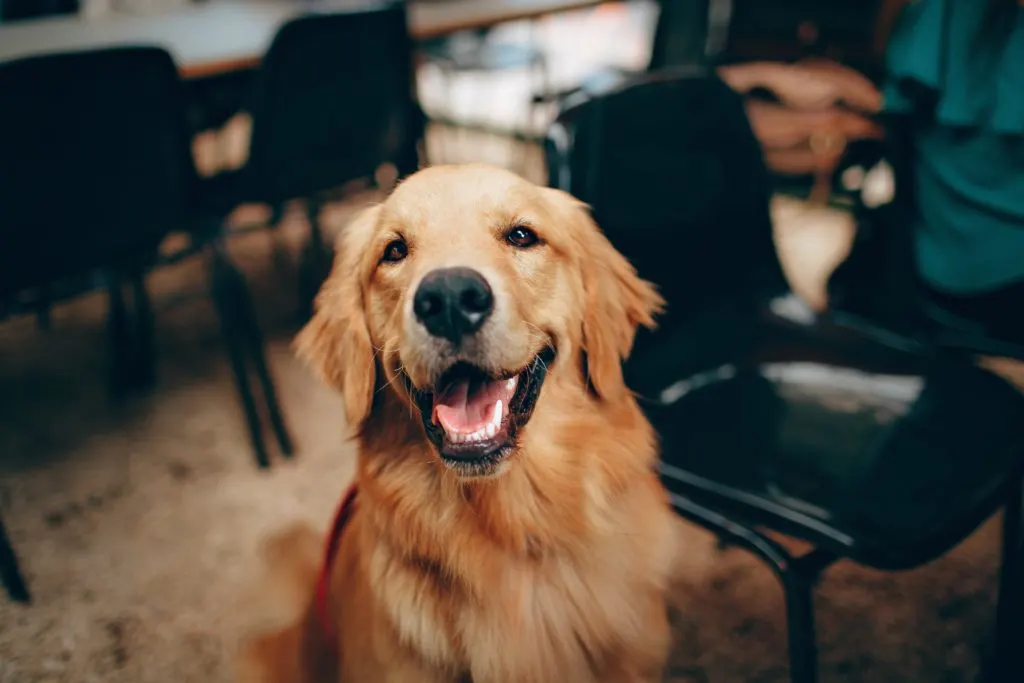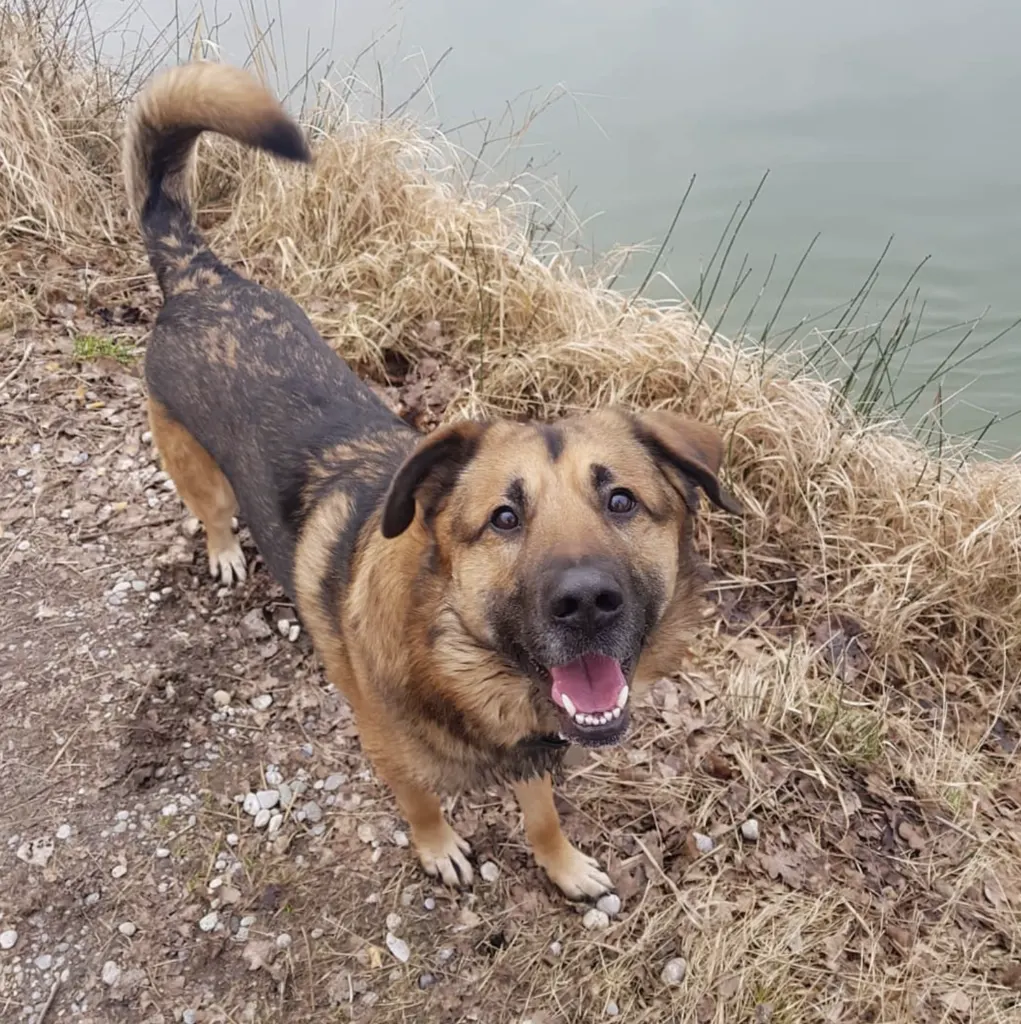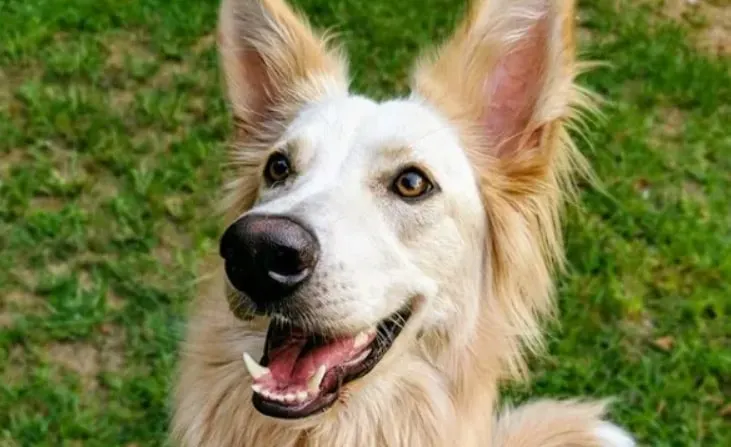On our page, we’ve covered different Golden retriever mixes such as the Golden Retriever Dachshund mix or the Border Collie Golden Retriever mix. However, the German Shepherd Golden Retriever Mix or short Golden Shepherd (too cute, I know!) or German Retriever is probably our favorite! You will see why!
The Golden Shepherd is probably one of the most energetic, fun, and friendliest pup you will meet. But besides this, they are also unbelievably loyal and intelligent! The German Shepherd is brave and loyal, which makes it a perfect watchdog.
If we keep the traits of both parent breeds in mind, we can say that with the German Shepherd Golden Retriever Mix you’re getting the best of both worlds. You’re getting the friendliness and kindness of the Golden Retriever and the loyalty and obedience of the German Shepherd.
But, with mixed-breed dogs, we can never know what exactly the mix will look like or what their personality will be like. That is why it is best to look at both parent breeds separately. In this case, we will look at the appearance and personality of the German Shepherd parent and the Golden Retriever parent in order to get a better picture of what the Golden German Shepherd will be like.
If you want to find out if the Golden Retriever German Shepherd mix would be a good dog for you, take a look at our article “Is the Golden Retriever German Shepherd mix a good dog?“, because there is a lot to know!
German Shepherd parent
The German Shepherd is an older dog breed that is recognized by the American Kennel Club. When it comes to physical strength and mental awareness, the German Shepherd appears to have both. German Shepherds are powerful, nimble, and well-built canines. They walk with a long, loping stride that makes it easy for them to keep up with the demands of their jobs. They have a long muzzle, a square head, and pointed ears that are upright and erect. These dogs also have long, bushy tails and slightly slanted back and hind legs.
German Shepherds have a double coat, which means they have a thick undercoat and an outer coat that is either straight or wavy. This also means the GSD year-round. They have a medium-length coat that is normally tan and black, although it can also be red and black. They usually have black masks on their faces, as well as black saddle patches on their back.
Coat color and size
Besides the most common coat color, the German Shepherd’s coat can be in a variety of other colors including:
- Black and silver
- Liver
- Sable
- Black and tan
- Blue
- Grey
- Black and red
- White
Standing 24 to 26 inches tall and weighing between 75 and 95 pounds we can say that the German Shepherd is a large dog. While we are talking about their size, we need to say that females are usually smaller than males. Because of their stature, they are able to move with grace, agility, and suppleness.
There are two main varieties of German Shepherd, German and American. Heavy, straight-legged, long-coated dogs are the hallmarks of German lineage. It’s claimed that these canines are better suited for the rigors of the field. The American version has a more sloped back, inclined hind legs, and a more fine-boned structure. There are some who prefer the look of the American breed, but there is some debate concerning the health and soundness of the dogs’ bone structure, so this preference has been curtailed.
The personality of the German Shepherd
It is typical of the German Shepherd to be cautious and reticent. As a result, it takes time for them to build relationships with people they don’t know. But once they get to know you and learn to trust you a German Shepherd will be your best buddy for the remainder of their lives.

German Shepherds are known for their steadfast devotion and protective nature. They’ll do all it takes to keep their house and loved ones safe.
An additional benefit of owning a German Shepherd is that it is a highly trainable dog breed. That’s why militaries and police forces all over the world prefer GSDs.
Other pets and children
If raised with children and other pets, German shepherd dogs can get along well with them, although they tend to be wary of strangers. The breed is regarded as intelligent and easy to teach.
It’s best not to leave your German Shepherd unattended for long periods of time. They’ll get bored and frustrated, which can lead to difficulties like chewing or barking, as well as anxiety and other behavioral problems.
German shepherd dogs that have been bred incorrectly can be prone to being very agitated. Overprotection and aggressive behavior are dangers when combined with a lack of socialization and training. The most crucial component of training a dog is exposing it to other dogs, people, and animals as early as possible. You can’t have a well-behaved dog if you don’t do that with your puppy.
German shepherd dogs should be socialized and obedience-trained from an early age in order to avoid over-guarding and violent behavior. They should not be restricted to a kennel or backyard, either alone or with other dogs, and should be constantly exposed to humans and other pets in the community.
Golden Retriever parent
Male Golden Retrievers stand between 23 and 24 inches tall and weigh between 65 and 75 pounds. Females stand 21.5 to 22.5 inches tall and weigh 55 to 65 pounds on average. Golden Retrievers achieve their full height and mature weight at one year and two years of age.
The golden retriever has a water-repellent coat that is wavy or flat in texture and ranges in hue from gold to cream. The feathering on the neck, legs, thighs, bottom, and tail is one of the breed’s most appealing traits.
The dog’s head is large and powerful. Although the ears are small, they are placed high on the head and hang just below the jawline. The chest is broad, and the body is in good proportion. Golden retrievers have a life expectancy of 10 to 13 years.
Coat color
Their coloring ranges from light golden to cream, and dark golden to golden, and their physique can vary from broad and dense to leaner and more sporty. According to American Kennel Club standards, goldens move with a smooth, powerful gait, and the feathery tail is carried, as breed fanciers say, with a “merry action.”

Golden retrievers shed often and a lot, so they require regular brushing. Thanks to their breeding as hunting and waterfowl-retrieving dogs in the Scottish Highlands, their outer coat is dense and repels water. They also have a thick undercoat. Their coats can vary in texture from wavy to straight. Heavy feathering appears on their chest, the backs of their legs, and their tail.
The personality of the Golden Retriever
Golden retrievers are kind, joyful, and friendly animals. They’re also warm, clever, and loyal. Golden retrievers are unique because they are the ideal family dog. You’ll be hard-pressed to find a more affectionate, outgoing, eager-to-please friend from a personality standpoint. They are ideal for playing in the backyard with children while they are young.
A golden retriever has to live inside with the people he cares about the most. They consider themselves as family members who must be treated as such. Goldens, on the other hand, are unaffected by noise, bustle, or activity, making them highly patient with children.
Goldens are eager to please their owners and love having a task to complete, such as fetching the newspaper or waking up the youngsters, because they were bred to work with people.
When you’re out and about, their cheerful temperament attracts the attention of other people—goldens get along well with strangers and other canines. Although they are not regarded as ideal security dogs (they would rather show an intruder where the treats are than chase him away), golden retrievers make excellent service dogs due to their devotion, intelligence, and steady demeanor.
Golden retrievers were bred to be working dogs, so they have a lot of energy and require a lot of action. They are best suited to owners who lead an active lifestyle and thrive in a home where someone is available to spend time with them during the day. They don’t do well when left alone at home since they are too attached to their humans.
Personality the German Shepherd Golden Retriever mix
The Golden Retriever German Shepherd mix is a crossbreed or designer dog that has gained popularity in recent years.
As we have already mentioned in the introduction, this is a mix between a purebred Golden Retriever and a purebred German Shepherd. But, if you are considering getting this designer dog, you should also know that you can get second-generation mixes which are two Golden Retriever German Shepherds bred together. It is just that this variety is still quite rare, so you will have to find a reputable breeder, someone you can trust.
Originally, the German Shepherd was bred as a herding dog. They are presently used as working dogs in almost every field where a dog may be used, and are particularly popular as police and army dogs due to their intelligence and fearlessness.
Next, we will talk about this designer dog’s temperament! The Golden Shepherd is a crossbreed, and as it is with any crossbreed it’s very hard to predict exactly what their personality and temperament will be! This is because the puppies will inherit different percentages of each of their parents’ traits. But don’t let that be a discouragement, I will explain why!
What the Golden Shepherd is like
The German Shepherd Golden Retriever mix is a gregarious and friendly pup who enjoys being at the center of the family’s activities. Unlike his German Shepherd parent, he gets along with everyone in the family and isn’t solely focused on his master. Strangers and outsiders find him affable, and he is rarely aloof. With that stated, he will frequently bark to alert his master when someone is approaching the gate, but this is more of a greeting bark than a danger bark. He would not hesitate to protect his family if yours was in urgent danger.

Source: Instagram (@sweeney2669)
The Golden Shepherd is a noisy and energetic dog, which can lead to destructive behavior if he is left alone for an extended period of time or becomes bored and restless. He is, however, amusing and always up for a game of fetch in the garden if you heed his exercise needs. His German Shepherd’s parents instilled in him an investigative instinct. If there are even the tiniest gaps in the enclosed fencing, this curious dog will most likely discover a way out.
Obsessed with human affection
This dog is obsessed with human affection and companionship since he is a social butterfly like his Golden Retriever parent. He is extremely close to his family, and as a result, he is likely to experience severe separation anxiety. As a result, he should never be left alone for more than a few hours, and if you plan on doing so frequently, the Golden Shepherd is not the dog for you.
If they have inherited their German Shepherd parent’s guarding attitude, they can make excellent watchdogs. They’ll let you know if there’s anything unusual happening in the house. But if they have inherited the traits of their Golden Retriever parent, you won‘t be able to use them as watchdogs because they are more likely to lick an intruder to death.
This dog loves being around other dogs and hates being alone. When you’re busy, they’d love to have someone to play with. Having another dog around all of the time aids in their socialization. If having two dogs is too much of a commitment for you, schedule doggie play dates and visit dog parks to meet new people.
Physical characteristics of the German Shepherd Golden Retriever mix
The Golden Shepherd can vary in size, because this is a mixed breed we can‘t give you completely accurate information on their size. But, judging by the size of their parents, this mix will always be somewhere between 22 and 26 inches tall, and they will weigh between 55 and 85 pounds.
The females will of course be smaller and lighter than the males, just as it is with all other dog breeds. Because of their nature, the Golden Shepherd makes a great family dog (they get along with kids super well!).
His ears are triangular in form and huge. They’ll either stand up straight or flop down next to his jawline. He has a long and thick tail, as well as huge paws. He’ll have enormous dark eyes and a lengthy muzzle that reaches all the way to his broad cranium.
Coat color
When it comes to the color of these dogs, it’s always a surprise (even for the breeders)! Given that the German Shepherd has a black and tan coat, and the Golden Retriever has a golden coat, the Golden Shepherd could have any combination of these coat colors!
But, they are most commonly gold, black, and tan, and they will have a golden coat with a black muzzle and ears.
Their coat, on the other hand, is more certain: it will be a long, thick double coat. Depending on whose parent they take after, it may be rough or smooth. Because of the double coat, shedding is inevitable, especially during shedding season.
Depending on whether they are descended from the Golden Retriever or the German Shepherd, their fur may be silky or rough.
Grooming
Grooming is an important part of owning a dog. but how much does the Golden Shepherd shed? Well, this dog is part Golden retriever, so what else can you expect but a dog who sheds like a little monster! So daily brushing is a must! Also, you will have to take your Golden Shepherd to the groomer regularly to be washed and have its fur trimmed.
If you want to keep your German shepherd golden retriever mix clean, you need to brush it. Otherwise, it could get dirty. It’s important to groom your dog every day if your dog is very active and does a lot of workouts. But even so, if the dog doesn’t go outside or play too much, you need to groom it twice a week. Often, people who own German shepherd dogs don’t give their dogs enough attention and neglect the routine care for their dogs and then get upset when their dogs get sick.
Don‘t forget the teeth and ears
A German shepherd dog’s health depends on how well it is taken care of. Dogs are more likely to get sick if you don’t take care of their fur, teeth, and ears.
To keep your Golden Retriever German Shepherd Mix clean, you will need to pay attention to its coat. Because we know that this dog breed sheds. You’ll also have to brush and cut your dog’s hair. But, you will additionally have to vacuum the furry coat that the Golden Shepherd most times sheds.
To make sure your Golden Shepherd is healthy, you will also need to check its ears. It’s because the dog’s ears have deep pockets that can quickly fill up with wax and get infected, which you can only see and spot if you look very closely and regularly.
This is kind of a given, but also remember to keep up to date with all their vaccinations, worming, and flea treatments!
Exercise
The German Shepherd Golden Retriever Mix is a high-energy dog and unsurprisingly very active, as both parent breeds are working dogs.
A high-energy mix may necessitate closer to 120 minutes of daily activity, which may include some running and games. Because these dogs need plenty of exercise, they will fit in best with an active family. So, if you’re looking for a hiking companion, look no further.

Source: Instagram (@golden_shepherd_max)
But please don’t overdo the exercise while your dog is still a puppy. You need to keep in mind that your dog is physically still in its developmental phase. Large breed dogs are predisposed to hip and elbow dysplasia, and we know that over-exercising during puppyhood can increase the risk. To know how much exercise your dog needs keep the following rule in mind:
- Exercise them for a maximum of 5 minutes for each month of age.
So, if your dog is 6 months old he will need 30 minutes of exercise daily.
Excellent swimmers
The Golden Shepherd is an athletic and enthusiastic dog who thrives in large houses or where he can go for long walks.
Because of the Golden’s hunting past, you may discover that your dog is an excellent swimmer. You can start by introducing them to water at an early age in a safe and controlled manner and allowing them to paddle. Swimming is a terrific way for your dog to get some exercise.
Lastly, if you want a dog who is a quick learner and who you can teach a lot of tricks the Golden Shepherd is perfect for you! Keep in mind that the most effective training method is positive reinforcement! They can also be very easily trained to herd, retrieve, and even as therapy dogs or guide dogs!
Training needs of the German Shepherd Golden Retriever mix
Because of its intelligence and eagerness to comply, this dog breed will be reasonably easy to teach and train, even for beginners.
You will find many articles online explaining how to train a dog, but don‘t fall for training myths. Almost all dog breeds thrive with reward-based teaching and positive reinforcement. Those two approaches are optimal to train almost any breed and crossbreed, including the Golden Shepherd. But what are positive reinforcement and reward-based training?
It is actually very simple. When your dog is acting the way you want it to, you’ll want to utilize plenty of treats and positive reinforcement to let them know what they did was good. And when it comes to unwanted behavior, you will ignore it. Never punish your dog!
Because both of its parent breeds are very intelligent dogs, mental stimulation will be beneficial to your dog throughout its life. If your dog develops the protective instincts that German shepherds are known for, early and frequent socialization will be an important element of its training.
You should also ensure that you are getting regular exercise in addition to cerebral stimulation. When it comes to learning new tricks and playing cognitive games and challenges, this breed will shine.
Health issues of the German Shepherd Golden Retriever mix
Health is an important aspect to consider before getting a certain breed or mixed breed. You should be aware of all the possible health problems your future best friend might face. Designer dogs are described as healthier than their purebred parents. According to many people, breeders manage to eliminate the most common health issues of both parent breeds creating a healthy mix. That is of course if you are buying your puppy from a reputable breeder.
Nevertheless, we need to take a closer look at the most common health issues of both parent breeds in order to be able to tell what the most common health problems of the German Shepherd Golden Retriever mix are.
Golden retriever health problems
Let‘s start with the Golden Retriever. The Golden Retriever breed has a lifespan of between 10 and 13 years and is known to have many health problems. Some of the health problems of this breed include:
- hypothyroidism,
- sub-aortic stenosis (SAS),
- eye disorders,
- elbow dysplasia,
- mast cell tumors,
- cancers,
- seizures,
- osteosarcoma,
- hip dysplasia,
- ear infections,
- cataracts,
- bloat (gastric dilatation-volvulus)
As you can see the list is very long.
German Shepherd health problems
German Shepherds on the other hand are considered to be healthy dogs, but, like all dog breeds, they are susceptible to certain health issues and conditions. The lifespan of the German Shepherd is 9 and 13 years, and the most common health issues of this breed include:
- bloat
- hip dysplasia
- arthritis
- elbow dysplasia
- degenerative myelopathy
- exocrine pancreatic insufficiency
With that being said, let‘s take a closer look at the health issues the family companion the German Shepherd Golden Retriever mix can suffer from.
Most common health problems of the German Shepherd Golden Retriever mix
Degenerative myelopathy
Degenerative myelopathy (DM), also known as chronic degenerative radiculomyelopathy (CDRM), is a spinal cord illness that causes weakening and paralysis in the hind limbs. The specific cause of this health problem is uncertain.
Early on, the symptoms of DM match those of osteoarthritis (arthritis), which is common in large breed dogs as a result of hip dysplasia, making diagnosis difficult.
The growing weakness and ataxia (wobbling, stumbling) in the later stages of the disease separate it from osteoarthritis of the hip joints.
Spinal traumas, tumors, lumbosacral stenosis, fibrocartilaginous embolism, myasthenia gravis, and discospondylitis are all possible causes of this illness.
Early signs and symptoms include:
- When standing still, the dog’s hindquarters appear to swing.
- His back paws “knuckle,” or turn under, causing the dog to walk on his knuckles, particularly when turning.
- The hind feet seem to scrape the ground when walking and sometimes the top surface of the feet becomes hairless and irritated from repeated trauma.
- When pushed from the side, the dog simply falls over.
- The dog has trouble coming out of the lying-down position.
Hip dysplasia
When a dog’s hip joint fails to develop normally, this is known as canine hip dysplasia. The hip is a ball-and-socket joint that can become extremely loose and unstable if the two components do not expand at the same rate.
Hip dysplasia in dogs can cause serious problems because if a dog walks around with a loose hip joint, the joint’s anatomy may be irreversibly destroyed. If ignored, the condition can lead to osteoarthritis (also known as a degenerative joint disease). Because of the uneven movement, the cartilage wears away, causing scar tissue and bone spurs to form.
Canine hip dysplasia is a hereditary disorder, which means it is passed down through the generations. If you’re considering getting a Labrador retriever, keep in mind that large breed dogs are more susceptible to the disease than small breed dogs. However, genetics isn’t the only factor that causes this illness in dogs. Puppies with a genetic predisposition to hip dysplasia are more likely to develop the illness if they are fed more than they require, resulting in faster-than-average weight gain and growth, according to experts. Another danger factor is puppy overexertion or too much exercise.
Bloat or gastric dilatation volvulus
Bloat, also known as gastric dilatation-volvulus (GDV), is a potentially lethal condition that affects dogs. The disease is known as “dilatation” which occurs when the stomach fills with air and mucous, ballooning to many times its normal size. The disorder is known as “volvulus” which occurs when the stomach flips or twists over itself, preventing air and mucus from moving into the rest of the gastrointestinal tract.
GDV is a life-threatening condition. The bloated stomach puts a lot of pressure on the major arteries in the abdomen and inhibits blood supply to the heart, causing cardiovascular problems and shock.
GDV can strike at any time, and owners must be aware of the symptoms and signs that accompany it. GDV is most common in German Shepherds, Great Danes, Irish Setters, Basset Hounds, and other large breed dogs with deep chests, but it can affect any dog. Dogs frequently display uneasy behavior. To signal that they are stressed or nervous, they may pace or whimper. Excessive salivation and drooling, as well as non-productive retching (trying to vomit but not getting anything), are common complaints among owners.
You may notice that a dog’s stomach appears to be larger or swollen. These are warning indications that your dog needs to see a veterinarian right now. Dogs who have it require surgery to recover. It is critical to act soon, or else the dog may not survive.
Diet of the German Shepherd Golden Retriever mix
We need to talk about what you need to know about Golden Shepherds and their diet. They are big dogs who need a lot of exercises, so they need a diet that fits their needs. An adult Golden Shepherd should eat about 3/4 to 1 1/2 cups of dry dog food every day. This should be split between two meals.
Keep in mind that the exact amount of food varies. It depends on the type of food itself and your dog‘s age. It’s not just a matter of quantity. The nutritional requirements of a puppy and an adult dog vary, and their food must reflect this.
When it comes to the type of food they should eat, we can‘t tell you which food exactly to get. We would recommend you do some research and make sure you get your food from a well-known company. The best thing to do is to buy a high-quality brand.
Obviously, your dog needs a well-balanced diet from which he will get all the necessary nutrients and micronutrients. It is important that your dog‘s food includes:
- protein
- carbohydrates
- fats
Finally, we think everyone knows this, but it won’t hurt to say it again. Keep your loving dog well-hydrated by giving him clean and fresh water at all times.
How much is a Golden Retriever German Shepherd mix?
Let‘s briefly cover the price of a German Shepherd Golden Retriever mix puppy. In the United States and the whole world, the price of this designer dog will vary depending on the breeder.
How much a puppy costs is generally determined by many factors. For example, the area you live in, how many breeders of that breed there are, and if the parents are champion dogs… Besides that, the popularity of the breed will affect the price as well. Believe it or not, sometimes it can happen that a designer dog is much more expensive than its purebred parents.
As for the Golden Shepherd, their price is between 600 and 1000 dollars. Some pages state that the price of this designer dog is between 500 and 800 dollars. But if you want a puppy from a good breeder, you will have to pay more. In fact, the price can even go up to 1500 dollars.
Conclusion on the German Shepherd Golden Retriever mix
Despite not being recognized by the American Kennel Club the Golden Shepherd is nevertheless a beautiful dog! They are smart and loyal, protective and loving pups. With their loyal disposition, they make the perfect family dog.
But, they do have a lot of energy and need a lot of exercises. This means they would feel best in a family that loves the outdoors! Hikes run and a lot of walks will be a must with this dog. He is not for families that prefer the inside!
Also, they are a lot of work. So be prepared for daily brushing and visits to the groomers at least once in two months.

